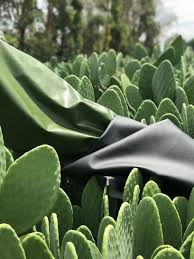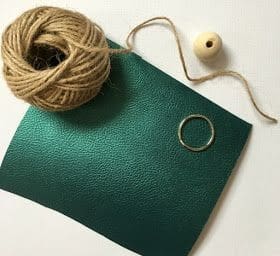
Eco-friendly, ethical and sustainable fashion is finally on the industry’s agenda and for many brands and designers this has been a year of awakening. But, as Tamsin Blanchard argues, we all have our part to play in making fashion truly circular.
Fashion is finally waking up to sustainability – but the lexicon surrounding eco-friendly and ethical fashion is fraught with inaccuracies. In ‘Get Your Greens’, an ongoing series launched to coincide with Earth Day 2019, Vogue explores how the industry is advancing towards a greener future.
Leather, a multi-billion-dollar global industry is probably the most ancient fabric used by humans. Leather will never be an animal-friendly product: It is made of dead animal skin. Animal’s skin is used to make leather, who are raised for their meat. In that sense, it uses a by-product from another industry, so it doesn’t actually need additional land and resources. The critiques regarding its source and the environmental impact due to the tanning process of leather are not new, they were born with the movement for the defence of animals and their treatment. According to an article by Lucy Siegle, journalist and writer on environmental issues, “290 million cows are killed per year to cover our current necessities and this numbers could duplicate in the next decade”. Higher volume of production does not only mean more animals being killed, but also translates into crueler treatment for them during their lives.
Also, due to several environmental impacts, the growing demand for leather and criticism is driving a keen interest in sustainable alternatives. Tanning is the most toxic phase in leather processing, with 90 per cent of production using chromium tanning Hides are doused in drums of water, chromium salts and tanning liquor to stop them decomposing and to give a supple, colour-fast leather. These variety of chemicals involved to treat the skin of the animal are extremely polluting and the problem aggravates in the developing world where there is less regulation and control regarding the waste disposal. Therefore, the obvious and first response by many ethical fashion brands was to produce items with Vegan Leather. But can leather also be eco-friendly?
There are not many options in the market yet, but they do exist. These include Ecolife™ by Green Hides, which creates eco-friendly, chrome-free leather in Italian tanneries that recycle and purify wastewater. The Leather Working Group is also promoting sustainable environmental practices within the leather industry.
CAN VEGAN LEATHER OFFER A SUSTAINABLE SOLUTION?


leather from cactus and pineapple
Can Vegan Leather offer a sustainable solution to the problem of environmental impact? Vegan leather has this name because it contains no animal products. However, it is not a new product but the result of decades of evolution of the pleather (plasticized synthetic leather). Actually, a good ally to fast fashion created to respond to the growing leather demand at lower prices. Produced with polyvinyl chloride (PVC) or polyurethane (PU), all relatives of petroleum. In their treatment they also produce very toxic chemicals but most importantly they will take forever to biodegrade given their plastic component.
New alternatives using biodegradable resources are being developed as what some call Vegetal Leather. Resources range from cork, wood, and mushrooms; to leaves and fruits of different plants like teak, pineapple or coconut for its water, including soy and kombucha tea…; incredible results are being achieved imitating leather! These materials do offer a solution regarding the origin and the environmental impact. In this same line, other promising alternatives are still under development such as ‘biofabrication’ of leather in a lab using cells and protein. We will have to wait to know more about this technology.
So these are the facts and the consumption options we currently have. The truth is leather and its alternatives have a lot to give in fashion design. The obvious advantage of Vegan Leather is that it does not have an animal origin. However, its components make it an enemy on the war against plastic, for some worse than Natural leather. Knowing that, it is a personal decision which kind of leather we want to consume. We can choose the last Vegetal alternatives that give a solution to both problems.
We can also make our decision regarding the urgency in our response to each problem: plastic vs. animal suffering. What is sure, if we want to be sustainable is that we can use what we have already before consuming any alternative keeping in mind that natural leather can last several lifetimes if properly treated. Rethinking our consumption patterns is as important as questioning the materials and the processes. We can create more and more sustainable alternatives to natural leather, but they will still require resources to be manufactured.
SUSTAINABLE LEATHER PRODUCTION

The Leather Working Group is a multi-stakeholder initiative involving brands, suppliers, manufacturers, NGOs and end users. It uses an audit protocol that assesses the environmental compliance and performance capabilities of tanners, and promotes sustainable environmental business practices within the leather industry.
The LWG estimates that 20 per cent of all footwear leather is covered by their audits, which assess chemical, waste, water management and safety matters relating to tanneries. Around 42 brands as well as 36 suppliers, and many more tanneries, are LWG members. Alternative tanning methods exist – after all, leather was produced for centuries without heavy chemicals.
Textile Exchange are working on a Responsible Leather Assessment tool. The luxury end of the market has seen a revival of the ancient technique of tanning with plant extracts. Bark, wood, berries, roots and leaves are used to colour and preserve the hides, producing far less harmful waste, and a biodegradable leather. It does however, take much longer than chemical processing.
The Tanners Extract Producers Federation (TEPF) is dedicated to spreading best practice among tanners to promote vegetable leather use for designers and consumers. It currently has 43 member organisations from the leather supplier sector.
Novo Campo promotes sustainable practices on cattle ranches in the Amazon region contributing to reducing deforestation.
Reference:
Common Objective. (2018, February 01). Fibre Briefing: Leather. Retrieved July 29, 2020, from https://www.commonobjective.co/article/fibre-briefing-leather
Sustainable Leather. (n.d.). Retrieved July 29, 2020, from https://www.sustainyourstyle.org/en/sustainable-leather
Natural leather or vegan leather: What is more sustainable? – Luxiders. (2019, January 31). Retrieved July 29, 2020, from https://luxiders.com/vegan-leather/

